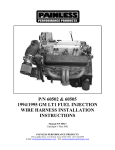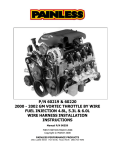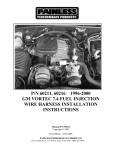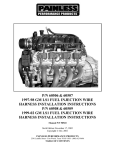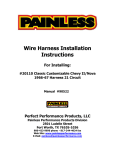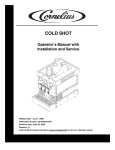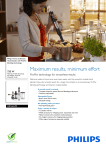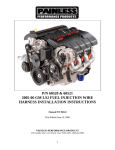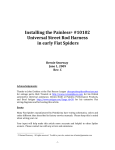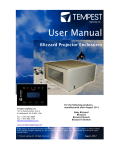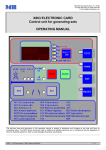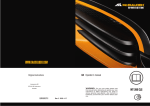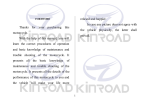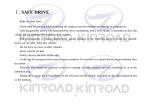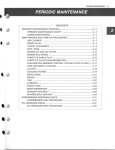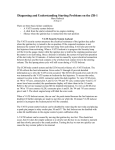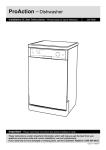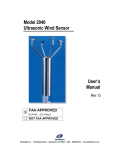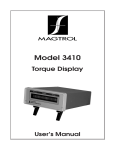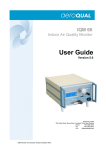Download Camshaft Installation Instructions For Installing
Transcript
Camshaft Installation Instructions For Installing: Part # 65206 – 1997-2004 (5.7L) LS-1 Engines Perfect Performance Products, LLC Painless Performance Products Division 2501 Ludelle St. Fort Worth, Texas 76105-1036 (800) 423-9696 We have attempted to provide you with as accurate instructions as possible, and are always concerned about corrections or improvements that can be made. if you have found any errors or omissions, or if you simply have comments or suggestions concerning these instructions, please write us at the address on the cover and let us know about them. Or, better yet, send us a fax at (817) 244-4024. For Technical Questions E-mail address: [email protected] Tech Line: (800) 423-9696 Perfect Performance Products, Inc. shall in no event be liable in contract or tort (including negligence) for special, indirect, incidental or consequential damages, such as, but not limited to, loss of property damage, or any other damages, such as, cost or expenses which might be claimed as the result of the use or failure of the goods sold herby, except only the cost of repair or replacement. February 2006 Revision #1 Copyright © 2006 by Perfect Performance Products, LLC. 2 1.0 INTRODUCTION Please read all instructions prior to install. Use these instructions as a guide to install the camshaft into your LS1 engine. Not all facets of the installation process are covered with these instructions. Certain elements of the installation have a number of different methods to complete them. These instructions include what we at Painless Performance Products have found to work the best for us. You, as the end user, will decide what the best method for your camshaft installation is. 2.0 TOOLS AND PARTS NEEDED FOR INSTALLATION You will at least need the following for this camshaft installation: Full set of mechanics tools Camshaft lube Silicone gasket sealant Carburetor cleaner New gaskets for the water pump (required) New gaskets for the valve covers, front engine cover and crankshaft front oil seal (It is recommended but not required to replace these gaskets.) New crankshaft balancer bolt (required) 3.0 PRE-INSTALLATION GUIDELINES During engine tear down it is recommended to inspect each engine part for excessive and/or abnormal wear. See engine manufacturer’s service manual for specifications. 3.1 Disconnect the battery. Drain the engine coolant. Remove the air-box if applicable. Remove the coolant passage hoses from the throttle body by squeezing the clamps with a pair of pliers (only if factory installed spring clamps are being used) and gently pulling on the hoses. Remove the radiator hoses and the heater hoses. Twisting the hoses back and forth may aide this. Remove the PCV tubing from the throttle body, intake and valve covers. Unplug the TPS and IAC connectors from the throttle body. The throttle body is held on with three bolts. Remove these bolts with a 10mm socket and set the throttle body aside. PCV routing 3 3.2 Using a break-over bar and a 15mm socket, release the tension on the main accessory drive belt and remove it. Do the same for the A/C compressor belt. Remove the upper and lower coolant hoses. Set them aside. Remove the A/C compressor, bracket, idler puller and tension pulley. The A/C compressor is held onto its bracket with four bolts. Use a 15mm socket to remove these bolts and the compressor. After the A/C compressor is removed, access is gained to the four bolts holding the A/C compressor bracket to the engine block. Remove these four bolts with a 15mm socket. The idler pulley and tension pulley are bolted to this bracket and are removed as an assembly. Corvette belt routing Camaro belt routing 3.3 The water pump is held on with six bolts. Remove the bolts with a 10mm socket and set the water pump aside. Now is a good time to clean the left over water pump gasket from the engine block. Use extra care when cleaning this sealing surface. Any scrapes or gouges of the aluminum will hinder the new gaskets sealing ability. Make sure none of the old gasket scraped from the engine block enters the coolant passages of the engine block. 3.4 Using a 24mm impact socket and an impact wrench remove the crankshaft balancer bolt. Do not discard this bolt. Using a two or three jaw puller, pull the crankshaft balancer off of the crankshaft. Set the crankshaft balancer and bolt aside. Crankshaft balancer bolt removal Crankshaft balancer pulley removal 4 3.5 Remove the front engine cover. There are eight bolts threaded from the front of the cover into the engine block and two bolts threaded from the bottom, through the oil pan and into the front engine cover. Remove these bolts with a 10mm socket. Set the front engine cover aside. Reinstall the crankshaft balancer bolt into the front of the crankshaft. Use a break over bar and a 24mm socket to turn the engine clockwise. Turn the engine until the alignment dot on the camshaft sprocket is at 6 o’clock and the alignment dot on the crankshaft sprocket is at 12 o’clock. This is top dead center number one cylinder. Doing this will aide in the installation of the camshaft. Bottom front engine cover bolts Front engine cover removal 3.6 Unplug the spark plug wires from the spark plugs. Remove the valve covers. Set the valve covers aside. 3.7 Using a 10mm socket loosen the rocker arm bolts enough to turn them to the side of each valve spring. Once the rocker arms are turned to the side, you can remove the pushrods just by pulling them up and out of the engine. Set the push rods aside. 3.8 The camshaft sprocket is attached to the camshaft with three bolts. Use a 10mm socket to remove these three bolts and the camshaft sprocket. Set them aside. The camshaft chain will fall down onto the crankshaft sprocket. Just leave the chain there for now. Behind this camshaft sprocket is the camshaft retainer. Remove the four bolts and this retainer. Camshaft sprocket removal Lifters and lifter cups 5 3.9 Removal of the camshaft. Before the camshaft can be removed, the lifters must be moved out of the way. There are several different ways to do this. First, under the engine heads there are lifter cups. When the camshaft is spun several times clockwise the lifters will go up into these cups. Friction between the lifters and the lifter cups usually holds the lifters up out of the way of the camshaft so it can be removed. But, sometimes this friction is not enough to hold the lifters up into the lifter cups and the lifters drop back down onto the camshaft. So, this method is not fail-safe and should be used cautiously if at all. If this method is chosen, spin the camshaft at least 5-6 times clockwise. At this point the lifters should be up in the lifter cups. The second method to holding the lifters up and out of the way involves magnets. If this method is chosen, 16 telescoping magnet pens with pocket clips will need to be purchased. The magnetic end of the pen needs to be small enough to fit through the pushrod hole in the engine head and long enough to reach the top of the lifter. Extend the magnet pens down into the pushrod holes. When the magnet pens reach the lifters they will attach themselves to them. Spin the camshaft clockwise to push the lifters up while holding up on the magnet pen. Bend pocket clip 60 degrees from the magnet pen and use this to hold the magnet pen and lifter up by wedging it to the engine head. A twenty inch board laid length wise on the engine head can also be used as a table for the magnet pen pocket clips to rest on. A third way to hold the lifters up out of the way of the camshaft is to buy specially manufactured LS1 camshaft swap tools. A search on the internet will lead you to these specialty tools and their manufactures for purchase information. 3.10 Use one of the three methods of choice listed above to move the lifters out of the way of the camshaft. To aide in the removal of the camshaft from the engine you will need to thread three long bolts into the end of the camshaft to use as a handle. The water pump bolts work well for this application. Or, you can use a camshaft removal tool. Use the three 10mm bolts in the end of the camshaft as a handle and remove the camshaft out of the motor. Caution: This camshaft removal process is delicate. Four bearings must be passed through with the camshaft lobes. Each camshaft lobe has sharp edges. These sharp edges will gouge the bearings and permanently damage them. Hold the camshaft inline with the motor as much as possible when pulling it out. You must support the weight of the camshaft against gravity and float it out of the engine. Twisting the camshaft back and forth may aide in this removal process. If the camshaft does not want to come out, push it back in and give it a few more turns to make sure the lifters are not holding it. Do not forcibly pull the camshaft out of the engine. 6 Camshaft removal 4.0 CAMSHAFT INSTALLATION GUIDELINES With a flashlight look down the camshaft bore into the engine block. The lifters can be seen in their upward position. 4.1 Remove the new camshaft from the camshaft box. Install the three 10mm bolts from the old camshaft onto this new one. These bolts will again be used as a handle to aide in the installation of the camshaft. Spray the inside and outside of the camshaft liberally with carburetor cleaner and wipe it with a rag. This is to remove all of the left over metal shavings from the manufacturing process. Apply camshaft lube all over each of the lobes and the bearing surfaces. 4.2 Carefully insert the new camshaft into the engine block. Caution: This camshaft installation process is delicate. The camshaft bearings are easily damaged by improperly installing the new camshaft. Hold the camshaft inline with the motor as much as possible. You must support the weight of the camshaft against gravity and float it into the engine. Twisting the camshaft back and forth may aide in this installation process. Remove the three 10mm bolts from the front of the camshaft after it is fully inserted into the engine. Camshaft installation 4.3 Reinstall the camshaft retainer and torque the four bolts to 18 lb/ft (25Nm) using a 10mm socket. Reinstall the camshaft sprocket by aligning the alignment dot on it to 6 o’clock. The crankshaft alignment dot should still be in the 12 o’clock position. 7 Wrap the camshaft chain around the camshaft sprocket and align the dowel pin on the camshaft to the hole in the camshaft sprocket. Thread the three camshaft bolts through the sprocket into the cam and torque them to 26 lb/ft (35 Nm). 4.4 If you used the telescoping magnet method to hold the lifters, remove them now. Reinstall the push rods. Gently push on the push rods until the lifters push down onto the camshaft lobes. Make sure the pushrods are correctly aligned to the lifters. Realign the rocker arms to the pushrods and the valves. 4.5 Note: Engine firing order is 1, 8,7,2,6,5,4,3. Cylinders 1, 3, 5 and 7 are on the left bank. Cylinders 2, 4, 6 and 8 are on the right bank. With the engine at top dead center number one cylinder do the following. Torque to 22 lb/ft (30 Nm) the exhaust rocker arms of cylinders 1, 2, 7 and 8 and the intake rocker arms of cylinders 1, 3, 4 and 5. Rotate the crankshaft 360 degrees. Torque to 22 lb/ft (30 Nm) the exhaust rocker arms of cylinders 3, 4, 5 and 6 and the intake rocker arms of cylinders 2, 6, 7 and 8. Take the old crankshaft balancer bolt out of the crankshaft. 5.0 ENGINE REASSEMBLY GUIDELINES 5.1 Replace the crankshaft front oil seal and the front engine cover seal at this time. Apply a small amount of silicone into the corners where the oil pan, front engine cover and the engine block mate. Install the front engine cover with the ten bolts loosely. The crankshaft balancer is a press fit onto the crankshaft. Several methods can be used to install this balancer onto the crankshaft. First method, use the old crankshaft balancers bolt to make an adapter. This adapter adapts a generic crankshaft balancer installation tool to work with this third generation engine. See below for guidelines to make this tool. How to make this adapter: Step one: Step two: Step three: Step four: Purchase a generic crankshaft balancer installation tool. Identify the threads where the crankshaft adapters thread into the tool. Purchase a die with this thread and a tool to use the die. Cut off the head of the bolt from the old crankshaft balancer bolt. Cut the bolt as close to the head as possible. 8 Step five: Using the die that matches the adapter threads, cut one inch of threads onto the cut part of the bolt. This gives you the crankshaft threads (M16, 2mm thread pitch) on one side of the bolt. This will thread into the crankshaft. The other side of the bolt will thread into the generic crankshaft balancer installation tool. A second method is to use a longer bolt with the same thread as the crankshaft balancers bolt. There are many websites offering bolts with the correct dimension or a local hardware store may stock one. This bolt must be at least the same hardness as the original crankshaft balancer bolt. Two to three inches more of length is desirable. A third method is to gain access to the factory General Motors tools used by the dealerships. The tool needed is part number J41665-2 and J41665-1 and they are manufactured by Kent-Moore tools. 5.2 Install the crankshaft balancer using one of the above three methods. The nose of the crankshaft should be recessed 0.094-0.176 inch into the balancer bore. Install the new crankshaft balancer bolt. First torque the bolt to 37 lb/ft (50Nm). Second, tighten the crankshaft balancer bolt 140 degrees more. A second person may be needed to hold the flywheel with a pry bar while tightening. 9 Crankshaft balancer to crankshaft tolerance. 5.3 Tighten the ten front engine cover bolts to 18lb/ft (25Nm). 5.4 Scrape the old gasket off of the water pump. Reinstall the water pump onto the engine block using the new gaskets. Torque the water pump bolts to 11 lb/ft (15Nm) and then to 22 lb/ft (30 Nm). Reinstall the valve covers. Torque the bolts to 106lb/in (12Nm). Reinstall the spark plugs wires onto the sparkplugs. Reinstall the A/C compressor bracket. Torque the four bolts to 37lb/ft (50Nm). Reinstall the A/C compressor and torque the four bolts to 37lb/ft (50Nm). 5.6 Reinstall the A/C compressor drive belt. Reinstall the main accessory drive belt. Reinstall the throttle body and torque the three bolts to 106lb/in (12Nm). Reinstall the coolant passage lines onto the throttle body. Plug in the TPS and IAC connectors to the throttle body. Reinstall the PCV hoses onto the throttle body, valve covers and intake. Reinstall the radiator and heater hoses and fill the system with coolant. Reinstall the battery cables. Check all fluids and top off if needed. Start engine. Immediately check for proper oil pressure (30-50 psi at idle). The engine will seem a bit noisy for the first few seconds of run time. This noise is normal and should subside after the first few seconds. Change the oil and filter after the first 100 miles with the new cam. 10 Painless Performance Limited Warranty and Return Policy Chassis harnesses and fuel injection harnesses are covered under a lifetime warranty. All other products manufactured and/or sold by Painless Performance are warranted to the original purchaser to be free from defects in material and workmanship under normal use. Painless Performance will repair or replace defective products without charge during the first 12 months from the purchase date. No products will be considered for warranty without a copy of the purchase receipt showing the sellers name, address and date of purchase. You must return the product to the dealer you purchased it from to initiate warranty procedures. Copyright © 2007 by Perfect Performance Products, LLC 11 Wire Harness Installation Instructions For Installing: Part # 65106 – 1997-2004 (5.7L) LS-1 Engines Part # 65206 – 1997-2004 (5.7L) LS-1 Engines Manual # 90538 Perfect Performance Products, LLC Painless Performance Products Division 2501 Ludelle St. Fort Worth, Texas 76105-1036 (800) 423-9696 We have attempted to provide you with as accurate instructions as possible, and are always concerned about corrections or improvements that can be made. if you have found any errors or omissions, or if you simply have comments or suggestions concerning these instructions, please write us at the address on the cover and let us know about them. Or, better yet, send us a fax at (817) 244-4024. For Technical Questions E-mail address: [email protected] Tech Line: (800) 423-9696 Perfect Performance Products, Inc. shall in no event be liable in contract or tort (including negligence) for special, indirect, incidental or consequential damages, such as, but not limited to, loss of property damage, or any other damages, such as, cost or expenses which might be claimed as the result of the use or failure of the goods sold herby, except only the cost of repair or replacement. P/N 90538 Perfect Performance Manual November 2005 Revision #3 Copyright © 2005 by Perfect Performance Products, LLC. 2 TABLE OF CONTENTS 1.0 2.0 3.0 4.0 5.0 6.0 7.0 INTRODUCTION……………………………………………………………………4 ABOUT THESE INSTRUCTIONS………………………………………………….4 TOOLS NEEDED……………………………………………………………………5 PRE-INSTALLATION AND HARNESS ROUTING GUIDELINES………………5 GENERAL INSTALLATION INSTRUCTIONS……………………………………7 5.1 Grounding the Vehicle……………………………………………………….7 5.2 Rough Installation……………………………………………………………8 5.3 Harness Attachment………………………………………………………….8 5.4 Terminal Installation Instructions……………………………………………8 GM LS-1 SYSTEM WIRING HARNESS INSTALLATION INSTRUCTIONS……9 6.1 Dash Group Installation…….………………………………………………..9 6.2 Sensor and Relay Installation………………………………………………..10 6.3 Engine Group Installation……………………………………………………12 TROUBLE SHOOTING INSTRUCTIONS…………………………………………15 7.1 TPS Pre-Adjustments………………………………………………………..15 7.2 Fuel Pump Relay Check……………………………………………………..15 7.3 The “Check Engine” Light…………………………………………………..16 7.4 Retrieving Trouble Codes from the Computer………………………………16 7.5 When to call Perfect Performance Products Tech Line……………………..17 LIST OF FIGURES FIGURE 4.1 FIGURE 6.1 FIGURE 6.2 FIGURE 6.3 FIGURE 6.4 FIGURE 6.5 FIGURE 6.6 FIGURE 6.7 FIGURE 6.8 FIGURE 6.9 FIGURE 6.10 FIGURE 6.11 FIGURE 6.12 FIGURE 6.13 FIGURE 6.14 FIGURE 6.15 FIGURE 6.16 ENGINE CONTROL MODULE…………………………………………….6 ASSEMBLY LINE DIAGNOSTIC LINK (ALDL) CONNECTOR………..10 HARNESS RELAYS...………………………………………………………11 HARNESS FUSEBLOCK…………………………………………………...11 MANIFOLD ABSOLUTE PRESSURE SENSOR (MAP)………………….13 KNOCK SENSOR…………………………………………………………...13 CAMSHAFT POSITION SENSOR…………………………………………13 OXYGEN SENSORS………………………………………………………..13 CRANKSHAFT POSITION SENSOR (CKP)………………………………13 DRIVERS SIDE COIL CONNECTOR……………………………………...13 INJECTORS 1,3,5,7 …………………………………………………………14 PASSENGER SIDE COIL CONNECTOR………………………………….14 INJECTORS 2,4,6,8 …………………………………………………………14 THROTTLE POSITION SENSOR (TPS)…………………...……………….14 IDLE AIR CONTROL (IAC)………………………………………………...14 ENGINE COOLANT TEMP. SENSOR (ECT)………………………………14 INTAKE AIR TEMP SENSOR (IAT)………………………………………..15 LIST OF TABLES Table 4.1 Table 6.1 Table 7.1 Compatible Parts List…………………………………………………………7 GM LS-1 Engine Group Connections………………………………………...12 Diagnostic trouble Codes……………………………………………………..17 3 1.0 INTRODUCTION Please read all instructions prior to install. You have purchased what we at Painless Performance Products, Inc. believe to be the most up-to-date and easiest-to-install automotive fuel injection kit on the market. It is designed for easy installation, even if you have no electrical experience. This kit is designed to be a complete system for fuel injection on all stock General Motors LS-1 engine (non-throttle by wire motors). This includes all wiring that is need by the computer to run and control the fuel injection system. Please note that the PERFECT computer does not have the capability to control an electronic transmission. If you are running a 4L60E transmission you will need to contact an aftermarket transmission company for that computer and wiring harness. If you are running a 700 R4 trans. and would like to have the lock-up functions you can purchase Painless Performance part # 60109 for that function. Usually, the computer, fuse block, relays, ALDL and check engine light can easily be mounted under the dash. Most of the wiring in the harness has been pre-terminated to the proper connector and all wire is rated at 275˚F and has been GM color-coded. This harness has been broken down into three major groups: Engine Group Includes wiring for the fuel injectors, coil plugs, sensors, fuel pump and coil power wire. Dash Group Includes ignition feed and tach. wires, ALDL, check engine light Fuse block and Relay Group Includes wiring for the fuse block, fuel pump relay, a/c relay, ignition relay, cooling fan relay ground and alternative fuel ground wire. 2.0 ABOUT THESE INSTRUCTIONS These instructions provide information for the installation of the 65106 LS-1 fuel injection wire harness kit. The contents of these instructions are divided into major Sections, as follows: 1.0 2.0 3.0 4.0 5.0 6.0 7.0 INTRODUCTION ABOUT THESE INSTRUCTIONS TOOLS NEEDED PRE-INSTALLATION AND HARNESS ROUTING GUIDELINES GENERAL INSTALLATION INSTRUCTIONS GM LS-1 SYSTEM WIRING HARNESS INSTALLATION INSTRUCTIONS TROUBLE SHOOTING INSTRUCTIONS AND TROUBLE CODES Sections are further divided into Paragraphs and Steps. Throughout, the figure numbers refer to illustrations and the Table numbers refer to information in the table form these are located in or near the sections or paragraphs to which they correspond. Always pay careful attention to any Notes or any text labeled CAUTION. 4 3.0 TOOLS NEEDED You will at least, need the following: Crimping Tool Wire Stripper Continuity Tester Electric Drill 1 5/8” Hole Saw Digital Volt Meter Note: Use a quality tool to avoid over-crimping. CAUTION: Do not use a test light to test the computer or sensor wiring or you will damage the computer. (for rubber grommet in the firewall) 4.0 PRE-INSTALLATION AND HARNESS ROUTING GUIDELINES The installation of your harness kit consists mainly of two parts: ~ The physical routing, positioning, and securing of the harness, wire groups, and individual wires and connectors. ~ The proper electrical connection of the individual circuits. These two major tasks are not separate steps, but are integrated together. That is you, will route some wires and make some connections, route some more wires and make some more connections. We cannot tell you how to physically route the harness in your vehicle. That depends a great deal upon the particular make of vehicle and what extent you want to secure and conceal the harness. We do offer some general guidelines and routing practices starting in Paragraph 4.2, GENERAL installation instructions concerning the electrical connections you will have to make beginning in Sections 6.0. To help you begin thinking though the installation of your wire harness, read the following sections: 4.1 You should get to know the particular engine that you are installing the harness on: THIS KIT WILL ELIMINATE THE MASS AIR FLOW (MAF) SENSOR, BUT WILL KEEP THE MANIFOLD ABSOLUTE PRESSURE SESNOR (MAP). IT WILL USE (1) OXYGEN SENSOR. THIS SYSTEM WILL ONLY WORK WITH A CABLE THROTTLE SYSTEM. IF YOU HAVE A LATER CORVETTE STYLE ENGINE YOUR WILL NEED TO CHANGE YOU THROTTLE BODY TO AN EARLIER STYLE. 5 Figure 4.1 Engine Control Module (ECM) 4.1.1 PAINLESS PERFORMANCE recommends the use of all proper parts. See Table 4.1 these parts will meet all requirements and are compatible with the Painless Performance harness and ecm. The numbers given are GM and AC Delco part numbers. 4.2 Familiarize yourself with the harness by locating each of the harness groups and by looking at the connectors on the wire ends. 4.3 Decide where and how the computer and relays will be mounted. Painless Performance wire harness kits are designed to mount either under the dash or on the lower kick panel. They must be no further apart than the wiring will allow (approx. 10 inches). 4.4 A good exercise is to lay out the wire harness on the floor beside your vehicle and identify all the connectors and wires. The harness must be routed from the inside of the vehicle out to the engine compartment. 4.5 You will want to route the harness through and around open areas. Inside edges provide extra protection from hazards and also provide places for tie wraps, clips and other support. 4.6 Route the harness away from sharp edges, exhaust pipes, the hood and door hinges. 4.7 Plan where harness supports will be located. Use support approximately every 6 inches unless the harness routes under the floor carpet. 4.8 Allow enough slack in the harness at places where movement could possibly occur (body to frame, frame to engine, ect.) 4.9 The harness should be bundled into harness groups. Use tape, nylon ties or poly-split loom. 6 LS-1 Fuel Injection Harness (1997-2004) Part # 65106 Engine Coolant Temp …GM #12551708 Throttle Position Sensor …Delco #213-912 MAP Sensor …Delco # 213-331 Knock Sensors …Delco# 213-362 CMP Sensors …Delco # 213-335 Micro Relays …Delco # D1703-A Intake Air Temp Sensor …Delco # 213-243 Oxygen Sensor …Delco # AFS 105 IAC …GM #17113391 Coils …Delco #D580 CKP Sensor …Delco # 213-354 Table 4.1 Compatible Parts List 5.0 GENERAL INSTALLATION INSTRUCTIONS CAUTION: Do not disconnect the battery or computer connector(s) while the ignition is on. Do not short any wire in this harness to ground (with the exception of labeled ground wires) or damage to the computer will result. Giving or receiving a jump-start may damage the computer. Do not use a test light when testing computer sensors or computer circuits. Damage to the computer will result! Notes: ~ There is a normal, small current drain on this fuel injection system. ~ Each connector in this harness is different and will not fit in the wrong place. NEVER FORCE ANY CONNECTOR ~ When connecting the plugs to the computer USE EXTREME CARE to make sure none of the pins in the computer are or have become bent. ~ The fuel pump and pressure regulator you use MUST maintain a constant pressure of 58 PSI (pound per square inch). If using a higher pressure pump you must add an inline regulator to bring the pressure down to the 58-60 range since the LS-1 fuel system does not have a built-in regulator on the fuel rail as in many earlier GM fuel injection systems. 5.1 Grounding the vehicle A perfectly and beautifully wired automobile will nevertheless have problems if everything is not properly grounded. Don’t go to the effort to installing a quality wire harness only to neglect proper grounding. Note: The installer of this harness is responsible for all ground wires not provided with this kit. 5.1.1 5.1.2 5.1.3 Connect a ground strap or cable (minimum of a 4 GA. wire) from the negative battery terminal to the chassis (frame). Connect a ground strap from the engine to the chassis (frame). DO NOT RELY UPON THE MOTOR MOUNTS TO MAKE THIS CONNECTION. Connect a ground strap from the engine to the body. 7 5.2 Rough Installation CAUTION: Disconnect the battery power from your vehicle by removing the negative battery cable from the battery. Note: Make no wire connection or permanent mounting of any kind at this time. 5.2.1 5.2.2 5.2.4 5.2.5 Position the computer in its intended location. Drill a 1 5/8” hole in the firewall near the computer for the engine group wires to pass through. Route the engine group section through the hole. Push the grommet (already installed on the harness) into the hole until it is seated. Route the dash section group to the driver’s side of the car. Route the fuse block and relays to the area where they will be mounted. 5.3 Harness Attachment 5.2.3 Note: Harness routing and shaping will be a time-consuming task. Taking your time will enhance the beauty of your installation. Please be patient and take your time. 5.3.1 Permanently mount computer. You should mount the parts (sensors, relays, etc.) that will be used for your engine at this time. 5.3.2 Mold harness groups to the connectors of the engine, frame and etc. Remember to route the harness away from sharp edges, exhaust pipes, hinges and moving parts. 5.3.3 Attach harness groups to your automobile with clips or ties starting at the computer and working your way outward. Note: Do not tighten tie wraps or mounting devices at this time. Make all harness attachments LOOSELY. 5.3.4 When used every 1 ½” or so on the visible areas of the harness, plastic wire ties make a very attractive assembly. Otherwise, a tie installed in other areas every 6” or so will hold the wires in place securely. REMEMBER TO TAKE YOUR TIME. 5.4 Terminal installation instructions Note: 5.4.1 5.4.2 5.4.3 5.4.4 In the following steps you will be making the circuit connections for the fuel pump, A/C compressor, Ignition and electric fan relay ground. Before you start, you should carefully read Sections 6.0 through 7.0, as applicable, and continually refer to the wire connection charts, DOUBLE CHECKING your length connections. These directions are for the wires which do not have a connector already installed on them. Have all needed tools and connectors handy. Select the correct terminal for the wire and application. Determine the correct wire length and cut the wire. Remember to allow enough slack in the harness and wires at places where movement could possibly occur. DOUBLE-CHECK YOUR CALCULATIONS. Strip insulation away from wire. Strip only enough length necessary for the type of terminal you are installing. 8 Note: 5.4.5 5.4.6 5.4.7 5.4.8 5.4.9 In the following step, make sure that the terminal is crimped with the proper die in the crimping tool. An improper crimp will not make a good connection. DO NOT OVER CRIMP. Crimp the terminal onto the wire. Connecting the wires and connectors throughout the harness is a repeating process. Make sure that each wire is first properly routed and then attached. DO NOT ATTACH AND THEN ROUTE AFTERWORD. When all wires are attached, tighten the mounts and ties to secure harness permanently. Attach the connectors to the computer BEGING CAREFUL NOT TO BEND ANY PINS Only after all connections have been made throughout the harness, connect the battery to the vehicle. CAUTION: Be sure the ignition is off when you reconnect the battery or you will damage the computer. 6.0 GM LS-1 SYSTEM WIRING HARNESS INSTALLATION INSTRUCTIONS 6.1 Dash Section Installation The wires in this group consist of the assembly line diagnostic link (ALDL) connector, the check engine light, ignition and tach wires (pre-mounted into a mounting bracket and four other wires). CAUTION: Do not make any connections while the harness is plugged into the computer Note: Wire color (example: BK/WT) is one wire with a stripe. The second color (the stripe) may not be bold. Observe all two-color wires closely. A. B. C. D. E. Find a suitable location to mount the ALDL connector that will allow access to the front of the connector and still allow you to see the “check engine” light while driving. Mount the ALDL connector. Locate the PK/BK wire and attach it to the fuse block or the coil power wire. POWER IS REQUIRED WHEN THE KEY IS IN THE RUN AND START POSITION. This is is the ignition power wire for the computer. Locate the Tan/Black wire labeled ALT.FUEL. If you are running a Camaro/Firebird engine with stock 26.5 LB/HR injectors ground this wire to the chassis. If you are running a Corvette engine with stock 29 LB/HR injectors do not ground this wire. When running the Corvette style injector be sure to isolate this wire by crimping a red butt splice onto the wire. This is to prevent the wire from becoming grounded. If you are running the 29 LB/HR injectors in a Camaro engine DO NOT USE THIS WIRE. Locate the GRN wire labeled FAN #1 and attach this wire to your electric fan relay ground (if available). This wire will send ground reference to the fan relay. 9 Figure 6.1 Assembly Line Diagnostic Link Connector (ALDL) 6.2 SENSOR AND RELAY GROUP INSTALLATION Note: If you have not already done so, read Sections 4.0 and 5.0 of these instructions and think through the installation of the harness before securing or cutting any wires. 6.2.1 Sensor and Relay Installation Note: The single RED wire with the female terminal that comes out of the fuel pump and ignition relay base is a test lead only. It is not connected to anything. See note in Section 7.1 The three relays that have been supplied for you in the kit are for the following: Fuel Pump Relay A/C Signal Relay Ignition Relay This relay will supply the 12 V ignition hot power to your fuel pump when the key is on and in start. This relay will supply a ground for the computer to increase engine RPM when the A/C compressor has been activated. This relay will supply 12 V ignition hot power to the O2 sensor, check engine light and computer when the key has been turned to on or start position. 10 Figure 6.2 65106 Relays and Relay Bases Note: You will have to install the relays in their housing after mounting the relay bases. All three relays are identical. Figure 6.3 65106 Fuse Block 11 6.3 ENGINE GROUP INSTALLATION The engine group is designed to be separated into the left side (driver) and the right side (passenger) sections. Each side is tie wrapped separately, BUT NOT LABLED. The right side of the engine has the connector for the IAC, TPS and ECT all of which ARE labeled. First separate the engine group into the left and right side sections and place them accordingly. 6.3.1 Before you connect any wires, separate the fuel pump and coil B+ wire from the engine group and place it out of the way. 6.3.2 Locate the two separate ring terminal grounds (labeled GRND#1 and GRND#2) in the harness. Place these wires on a ground source or engine bolt. Using Figure 6.4 and Table 6.1 connect the wiring as directed. Locate the PINK wire labeled COIL B+, connect this wire to a IGN. 12 V source that gets power in both start and run. 6.3.3 6.3.4 Wire Colors Blue, Lt. Blue Bk/Wt, Pur. Blk. Pk/Bk Bk/Wt, Lt. Grn. Gray Bn/Wt, Rd/Bk Yw/Bk Yel., Yw/Bk Rd/Bk Pk/Bk, Blue Pk/Bk, Green Pk/Bk, Green Pk/Bk, Blue Pk/Bk, Green Pk/Bk, Blue Pk/Bk, Blue Pk/Bk, Green Bk/Wt, Blue Gray Bk/Wt, Yel. Green Bk/Wt, Tan Lt.Grn/Bk, Lt.Bl./Bk. Lt.bl/Wt, Lt.Grn/Wt Pur., Red, Green, Lt. Blue Brown, Bk/Wt, Pink Rd/Wt, Pur./Wt, Lt. Bl/Wt Gr/Wt, Bk/Wt, Blk, Pink Blk., Bk/Wt Red Pink Tan/Blk # of Positions in Connector 2 4 Labeled Connects to: KNOCK OXY. Knock Sensor Oxygen Sensor 3 MAP MAP Sensor 3 CMP Cam Position 3 CKP Crank Position 2 2 2 2 2 2 2 2 3 Inj #1 Inj. #2 Inj. #3 Inj # 4 Inj # 5 Inj # 6 Inj #7 Inj #8 TPS Injector # 1 Injector # 2 Injector # 3 Injector # 4 Injector # 5 Injector # 6 Injector # 7 Injector # 8 TPS Sensor 3 ECT ECT Sensor 2 4 IAT IAC IAT Sensor IAC Sensor 7 Drvr. Coils 7 Pass. Coils Driver Side Coils Passenger Side Coils Engine Ground Starter B+ Term. Ign. Hot 12V Ground for FBody engines GRND # 1 & # 2 Starter B+ Coil B+ Alt. Fuel Table 6.1 GM LS-1 Engine Group Connections 12 Figure 6.4 MAP Sensor Figure 6.5 Knock Sensor Figure 6.6 CMP Sensor Figure 6.7 Oxygen Sensor Figure 6.8 CKP Sensor Figure 6.9 Drivers Side Coil 13 INJ #1 INJ #7 INJ #5 INJ #3 Figure 6.10 Drivers Side Inj. INJ #8 INJ #6 INJ #4 Figure 6.11 Pass. Side Coil INJ #2 Figure 6.12 Pass. Side Inj. Figure 6.13 TPS Sensor Figure 6.14 IAC Sensor Figure 6.15 ECT Sensor 14 Figure 6.16 IAT Sensor 7.0 TROUBLE SHOOTING INSTRUCTIONS Note: Only scanners with marine cartridges and marine cable plugs will communicate with the PERFECT computer. If you are having trouble with your engine running badly or not at all, first perform basic trouble shooting( checking for faulty connections, spark, fuel pressure, etc.) then see if the computer has stored any trouble codes in its memory.(See 7.3 and 7.4) 7.1 THROTTLE POSITION SENSOR ADJUSTMENTS Once you have installed the kit and are ready to start the engine for the first time you must first readjust the voltage that is going the Throttle Position Sensor. A. B. C. D. E. Turn on ignition but do not start engine. Check to insure throttle is not depressed. At the throttle position sensor, place a digitalis voltmeter’s probes into the blue and black wires in the back of the sensors connectors, which is plugged into the sensor. Find the throttle stop screw that is located on the passengers side of the housing. Re-adjust the screws until your volt meter reads .8volts. We are having you re-adjust the TPS to eliminate the chances of a stalling issue in long deceleration while driving. You should not have to worry about this issue, but if it occurs double check the voltage coming out of the TPS blue wire, and make adjustments accordingly. 7.2 THE FUEL PUMP RELAY CHECK The small RED wire that is coming out of the relay is a TEST lead wire. If you do not hear your fuel pump prime when you turn on the ignition take a jumper wire and connect it from a 12 V power source to the RED wire coming our of the FEUL PUMP RELAY. By supplying 12 V to that wire you are bypassing the relay completely. you should hear the pump run. If you do not hear anything, make sure that all connections are good and the pump has a sufficient ground. 15 7.3 THE CHECK ENGINE LIGHT Normally, the “check engine” light should come on when the ignition is initially turned on, and then go out a few moments after the engine starts running. If the computer has detected a problem and a trouble has been set the light will come back on. 7.3.1 The computer identifies particular trouble codes by flashing the “check engine” light in a certain way. The codes are read by counting the flashes: A: The first digit (the “tens” digit) of the code is flashed quickly, followed by a brief pause, then the second digit (or “ones”) is flashed, followed by a longer pause. For example, (3) three quick flashes followed by a brief pause followed by a two (2) flashes indicate code 32. The code will repeat itself two (2) times. The next code if any will be displayed in the same manner. B: Note: When you access the codes from the computer a code 12 (one flash followed by two flashes) will first be displayed. THIS DOES NOT INDICATE A PROBLEM. Code 12 will be flashed 2 times, followed by the particular trouble codes, if any. If the computer merely flashes code 12 there are no trouble codes stored. Code 12 means the engine is not running. 7.4 RETRIEVING TROUBLE CODES FROM THE COMPUTER 7.4.1 In order to retrieve the trouble codes stored in the computer, locate the ALDL plug installed in Section 6.2. Turn the ignition on, BUT DO NOT START THE VEHICLE. Connect a jumper wire from the ALDL terminal “A” to terminal “B” see Figure 6.1 and observe the check engine light. 7.4.2 After you have read any codes (remember the normal code 12) write them down for reference. Remove the jumper wire from the ALDL connector. 7.4.3 Take the codes one at a time and match them to the codes in Table 7.1. This will tell you in which circuit the computer has detected a problem. Note: A code indicates a problem is a specific circuit, NOT THAT A PARTICULAR PART IS BAD. 7.4.4 Before taking more extensive corrective actions for any trouble codes, make sure that all connections on the indicated circuit, INCLUDING THE COMPUTER, are clean and tight. Inspect the wiring in the circuit for any broken, shorted, or exposed wires. Finally, insure all grounds wires are clean and secure. 7.4.5 If you are getting a code from your computer and need to clear the code, other than code 12, after you have replaced apart, readjusted a part, etc. You can do this by making the following steps: 16 A: B: C: D: E: F: G: Install a jumper wire from terminal A to terminal B Ignition ON engine OFF Move throttle from 0% (idle) to 100% (WOT) and back to 0% Remove the jumper wire Turn ignition OFF for at least 20 seconds Ignition ON engine OFF Recheck for codes CODE # CIRCUIT AFFECTED 13--------Oxygen Sensor Inactive 14--------Coolant Sensor High Voltage (COLD) 15--------Coolant Sensor Low Voltage (HOT) 21--------Throttle Position Sensor (high voltage) 22--------Throttle Position Sensor (low voltage) 23--------Manifold Air Temp. (low temp.) 25--------Manifold Air Temp. (high temp.) 33--------MAP Sensor Circuit (high voltage) Table 7.1 Diagnostic Trouble Codes Chart 34--------MAP Sensor (high voltage) 41--------EST Fault 42--------EST/BYPASS fault 44--------Knock Sensor inactive 51--------Calibration checksum 54--------Oxygen Sensor (lean reading) 55--------Oxygen Sensor (rich reading) 81--------TPS (out of range) 7.5 WHEN TO CALL PERFECT PERFORMANCE TECH LINE 7.5.1 7.5.2 This harness kit has been built with the highest regard to strict quality control and tested before shipment. Before calling us please double-check all connections and perform normal basic trouble shooting (fuel pressure, ignition power and spark, etc.) If you have any questions concerning the installation of this harness or are having trouble in general; feel free to call Painless Performance tech line @ 800 423-9696. Calls are answered from 8AM to 5 PM CST, Monday-Friday, except holidays. Please leave a message if you are unable to reach us and we will return your call as soon as possible. Note: Helpful information on the PERFECT PERFORMANCE ECM Calibration The PERFECT ECM has been specifically calibrated for you particular engine. This computer will not work with any other type of engine, nor will it work with a modified engine (i.e. aftermarket parts). The computer has also been programmed to control your electric fan. 17 Painless Performance Limited Warranty and Return Policy Chassis, fuel injection harnesses, and Striker ColdShot units are covered under a lifetime warranty. All other products manufactured and or/sold by Painless Performance are warranted to the original purchaser to be free from defects in material and workmanship under normal use. Painless Performance will repair or replace defective products without charge during the first 12 months from the purchase date. No products will be considered for warranty without a copy of the purchase receipt showing the sellers name, address and date of purchase. You must return the product to the dealer you purchased it from to initiate warranty procedures. 18






























